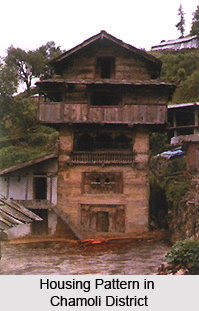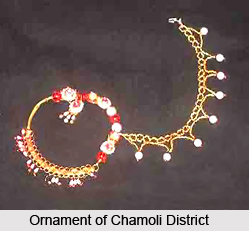 Culture of Chamoli District in Uttarakhand describes the lifestyle and traditional customs of the regional residents of this part of the country. Being the inhabitants of a mountainous region which are not influenced by the touch of urbanization, the people of Chamoli district follow their own distinctive and attractive culture, which is enriched with folksongs, folk dances, festivals and lots more. Various kinds of recreational activities are practiced by the local residents, who are fond of adorning themselves with ornaments of precious metals.
Culture of Chamoli District in Uttarakhand describes the lifestyle and traditional customs of the regional residents of this part of the country. Being the inhabitants of a mountainous region which are not influenced by the touch of urbanization, the people of Chamoli district follow their own distinctive and attractive culture, which is enriched with folksongs, folk dances, festivals and lots more. Various kinds of recreational activities are practiced by the local residents, who are fond of adorning themselves with ornaments of precious metals.
Housing Patterns of Chamoli District
Residential houses in Chamoli are devoid of any specific constructional planning and created in clusters near water springs or river banks. Generally, these dwellings are double-storeyed and made of stone, equipped with courtyards at the front known as `Chauk`. One can reach the second storey which is 2.1 metres in height with the aide of a wooden or mud staircase. `Patals` or quartzite slabs are employed to build the roofs of such houses, which are sloped. Galvanized iron sheets are utilized as materials to construct the roof, by the wealthy inhabitants of Chamoli. Balconies are also present, adjoining the upper storeys. Certain houses possess five or even six storeys, wherein the uppermost storey is used as household kitchens. The cattle sheds are built at a short distance from the villages.
 Food in Chamoli District
Food in Chamoli District
Jhanjhora, maize, mandua, rice and wheat represent the staple die of the people of Chamoli district. However, mandua, maize and jhanjhora are mainly consumed by the poorer sections of the society. `Masor`, `Urad`, `Lopia`, `Tur`, `Bhatt`, `Soontha` and `Gahat` are some of the pulses which are eaten by the locals. The Hindus residing here are mostly vegetarian and are fond of vegetarian foodstuffs. Sikhs, Muslims and Christians are non vegetarians, who are unable to afford such food items due to shortage of funds.
Jewellery of Chamoli District
Married women love wearing `Bichhuwas` or toe- rings made of silver, while nose rings or `Naths` made of gold and small nose studs known as `Keels` are also worn by them. They are quite fond of decorating themselves with different types of jewelleries which involve `chandanhar` or necklaces, `hansulis` or ornaments worn around neck and also necklaces equipped with beautifully coloured beads. Silver or copper amulets are used by married women, and `churis` or bangles made of silver, gold or coloured glass are favourites of young girls and women. Bhotiya womenfolk are also known to wear jewels made of ivory and regional men of Chamoli wear gold chains around their neck.
Costumes of Chamoli District
Men wear a long shirt referred to as `Kurta` alongwith a `Pyjama`. A jacket or `sadri` and a cap are also worn by men during the winter season. Buttoned up coats teemed with trousers form the dress of the rich. Women of Chamoli generally wear `Angra` or a full-sleeved shirt, along with a saree. During winter, woollen jackets are also worn by the ladies. Rural women are clad in a long scarf which covers the neck and shoulders, termed as `Orhni` and a tight, long sleeved jacket. Salwar-Kameez is worn by the girls, with a `dupatta`, which is again a long scarf that covers the head and shoulders.
Recreation of Chamoli District
The regional inhabitants of Chamoli district perform several folk songs and folk dances for entertainment. The `Thadiya` dance practised during `Basant Panchami`, `Mela` performed in Diwali and `Pandava` during winter are some of the most popular local dances. `Ghariyali` and `Jeetu Bhagdawal` are amongst the other famous dances of Chamoli. Open-air theatre acts called `Swangs` are also arranged by the local residents of Chamoli to add to the fun quotient in fairs and festivals, religious and social congregations.
Fairs and Festivals of Chamoli District
People of Chamoli district celebrate innumerable festivals and organise wonderful fairs which consist of `Nag Panchami`, `Ram Navami`, `Dussehra`, `Janmashtami`, `Makar Sankranti`, Diwali, `Raksha Bandhan`, Holi and `Shivaratri`. The various fairs hosted here are `Gaucher Mela`, `Nanda Devi Raj Jat`, and so on.






